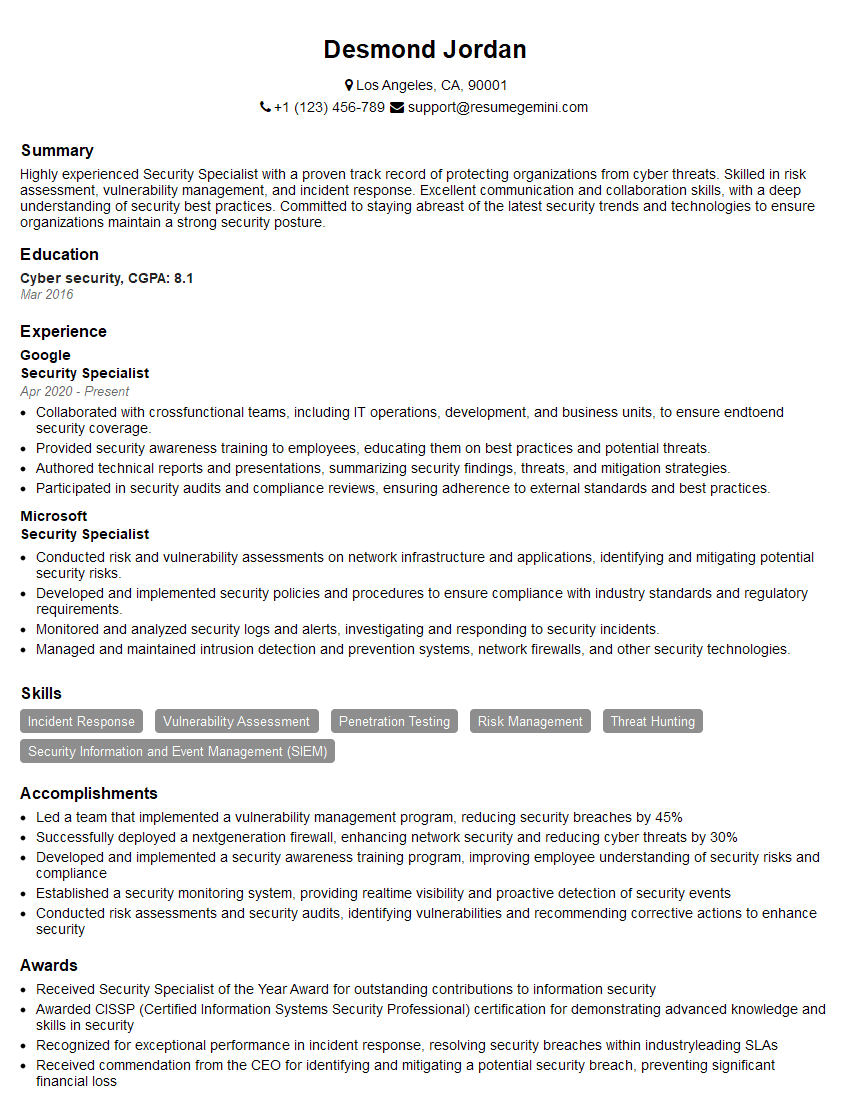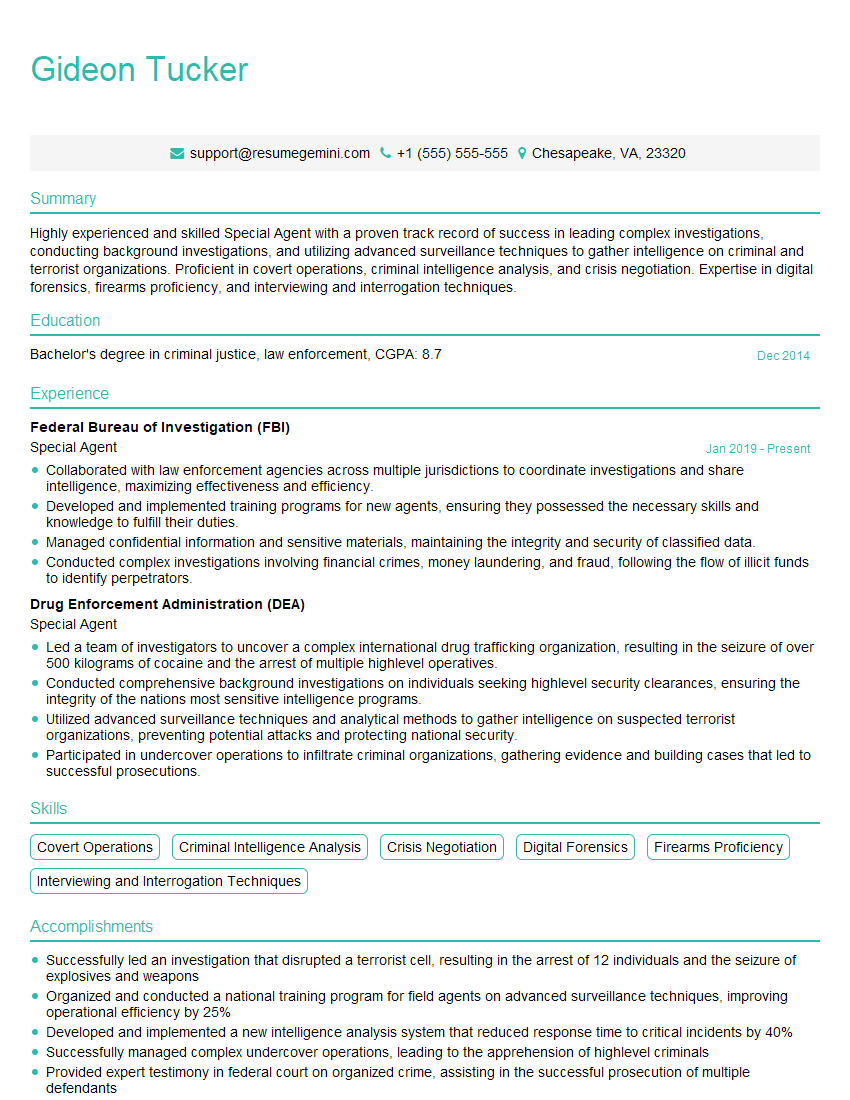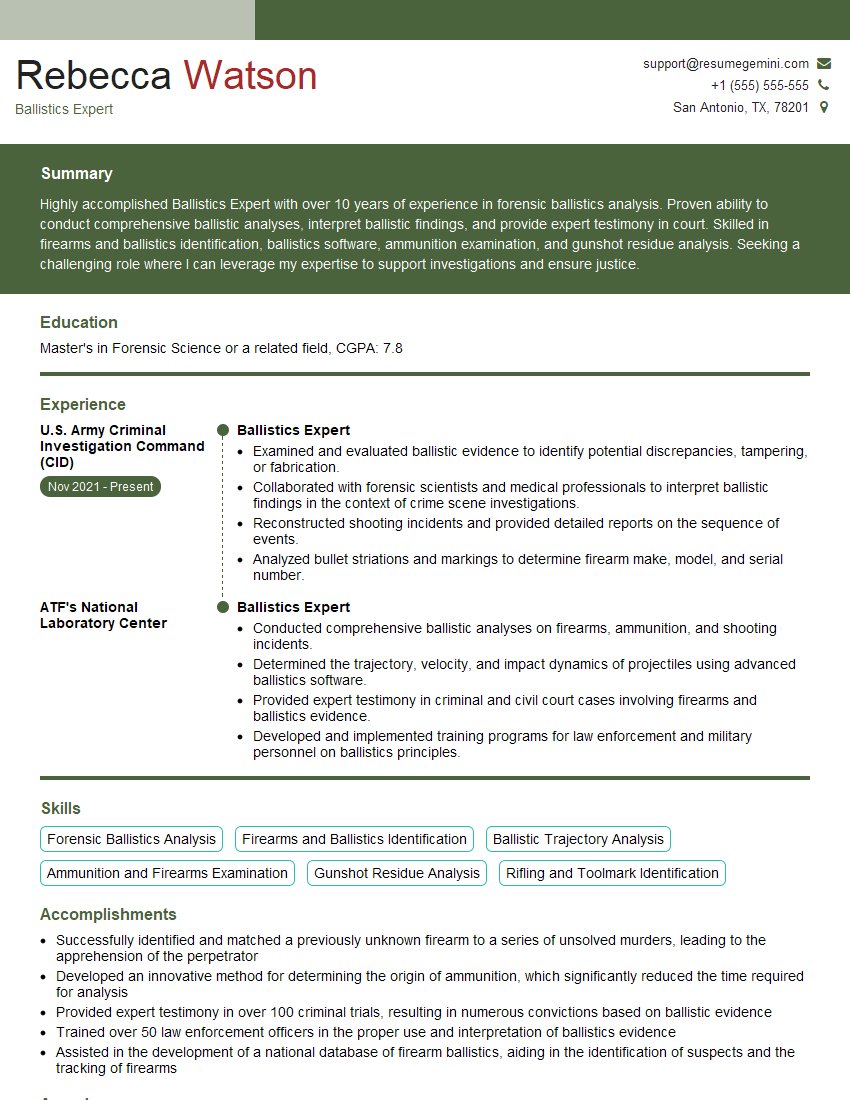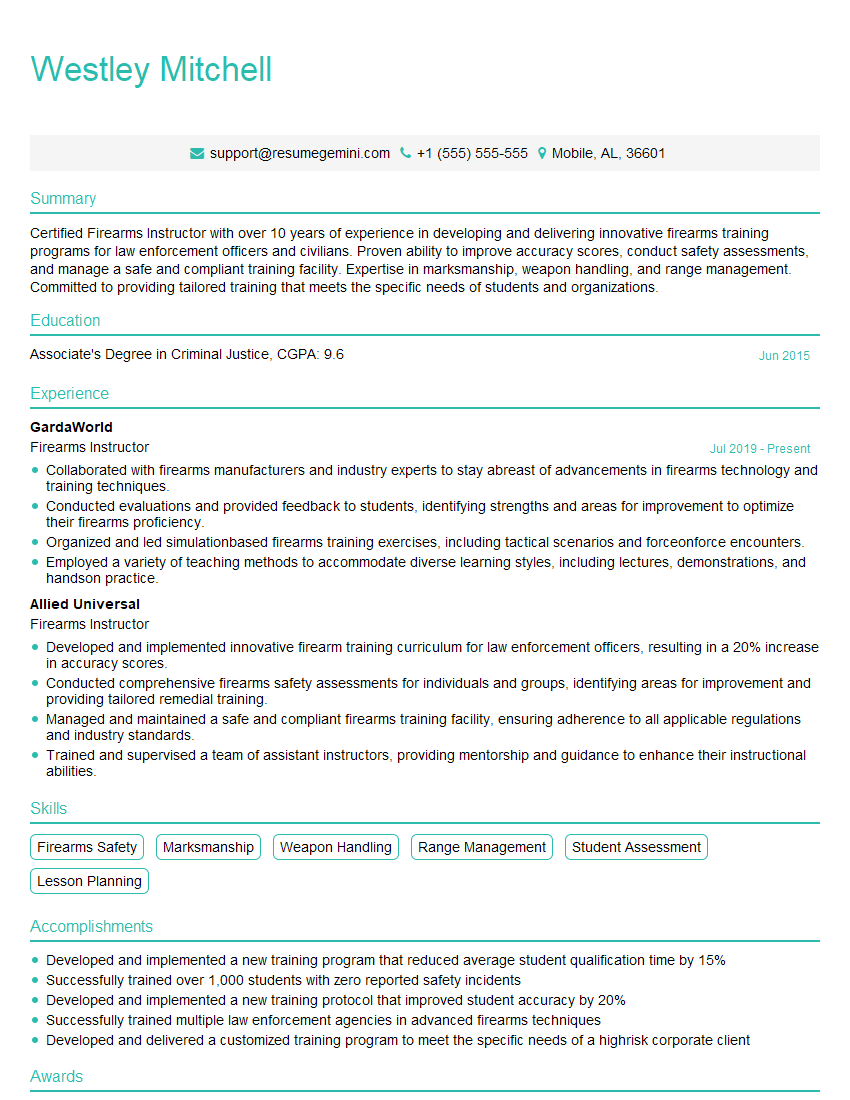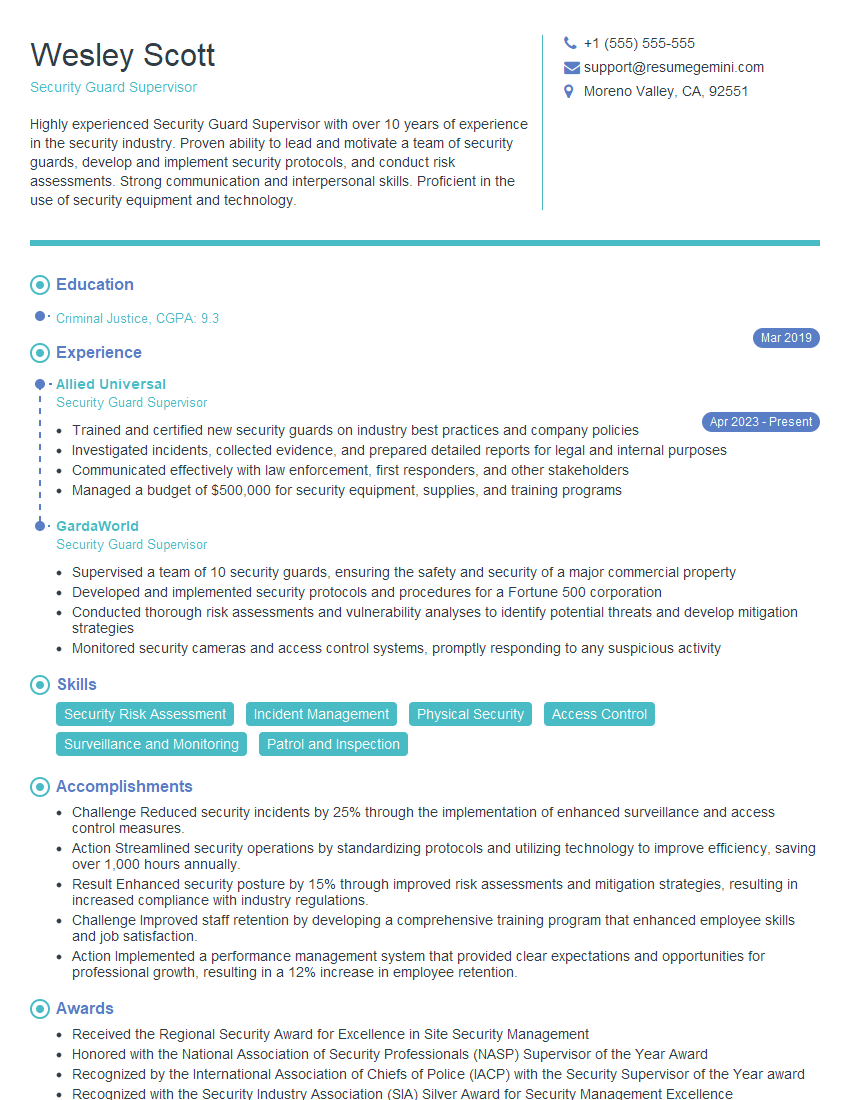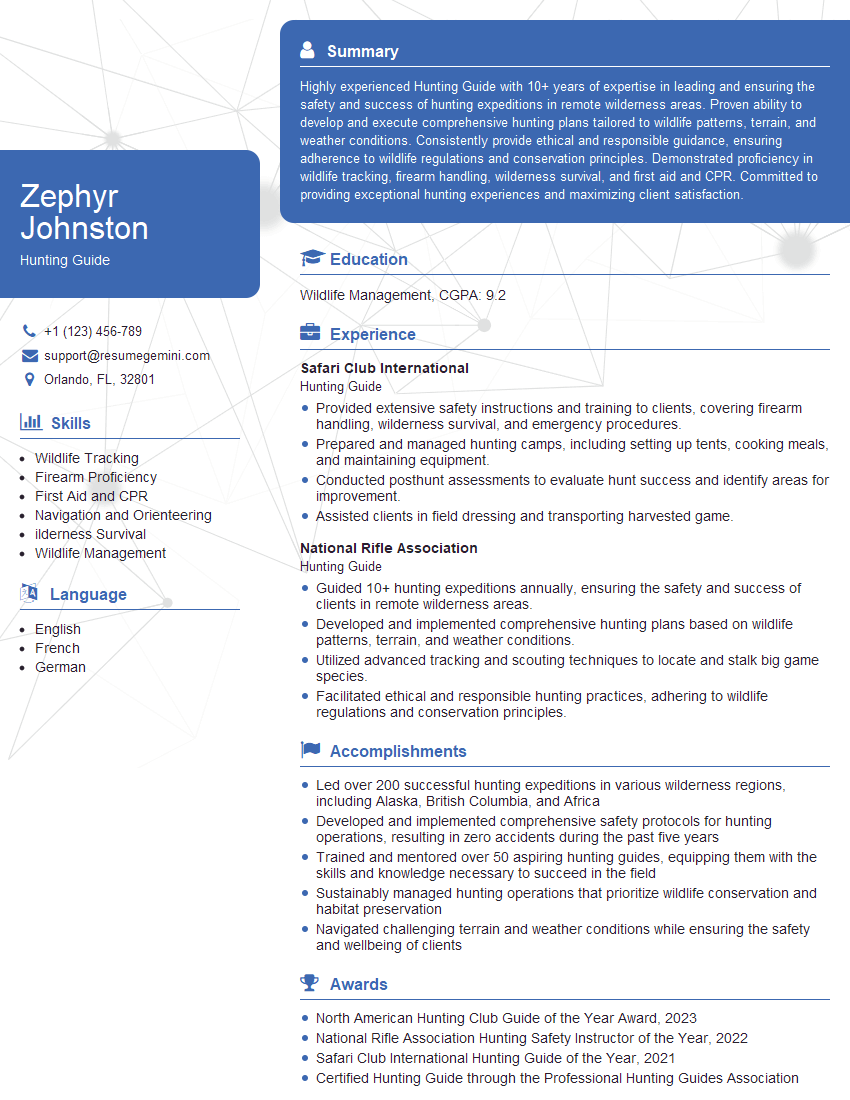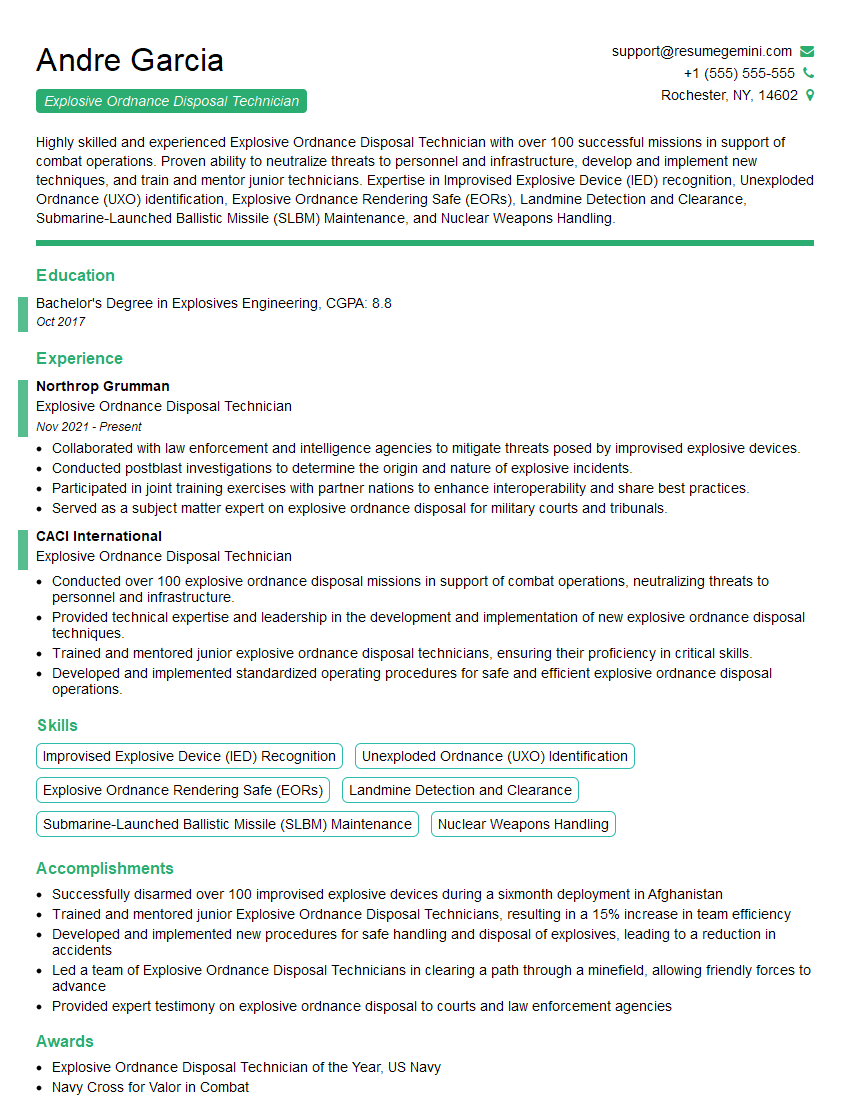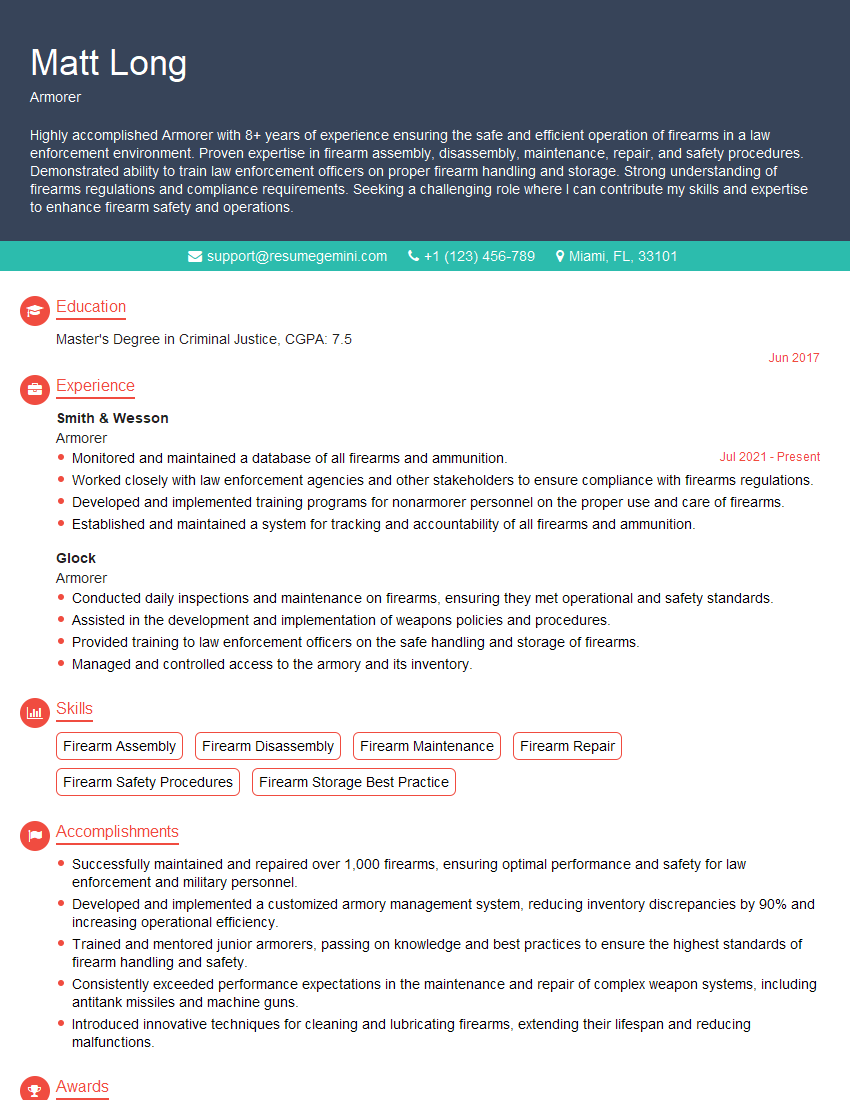Interviews are opportunities to demonstrate your expertise, and this guide is here to help you shine. Explore the essential Weapon Handling and Proficiency interview questions that employers frequently ask, paired with strategies for crafting responses that set you apart from the competition.
Questions Asked in Weapon Handling and Proficiency Interview
Q 1. Describe the four rules of firearm safety.
The four rules of firearm safety are fundamental and non-negotiable. They are the cornerstone of safe firearm handling, preventing accidents and ensuring responsible gun ownership. Think of them as a checklist you must go through every single time you handle a firearm, no exceptions.
- Rule 1: Treat every firearm as if it were loaded. This is the most crucial rule. Always assume the weapon is loaded, even if you’ve just checked it. This mindset prevents careless actions. Imagine you’re handling a gun you’ve visually inspected; this rule compels you to treat it as if a bullet is already chambered, avoiding any accidental discharges.
- Rule 2: Never let the muzzle cover anything you are not willing to destroy. Point the gun in a safe direction at all times. This prevents accidental shootings if the gun discharges. Think about your surroundings—are there people, pets, or valuables within the muzzle’s potential path? This rule forces a heightened sense of awareness of your environment.
- Rule 3: Keep your finger off the trigger until your sights are on the target and you have made the decision to shoot. This prevents accidental discharges caused by a trigger pull. Imagine you’re holding the gun, your finger must remain outside the trigger guard until the very moment you’re certain about your shot.
- Rule 4: Be sure of your target and what is beyond it. This rule emphasizes responsibility and prevents collateral damage. It’s not just about hitting your target; it’s about understanding the full trajectory of the bullet and what may lie in its path. Before every shot, picture the bullet’s path and the consequences of a missed shot.
Q 2. Explain the proper techniques for weapon cleaning and maintenance.
Proper weapon cleaning and maintenance are vital for the firearm’s functionality, safety, and longevity. Neglecting this can lead to malfunctions, jams, and even accidents. It’s like regularly servicing your car – neglecting it will lead to problems down the line. The process usually involves these steps:
- Safety First: Always ensure the firearm is unloaded and the action is open. Visually and physically inspect the chamber to confirm it’s empty.
- Disassembly: Carefully disassemble the firearm according to the manufacturer’s instructions. Improper disassembly can damage the weapon.
- Cleaning: Use a gun cleaning kit with appropriate solvents and brushes to clean all parts. Remove any residue, powder, or debris. Pay close attention to the barrel, breech, and action.
- Lubrication: Apply a suitable gun oil or grease to moving parts, ensuring smooth operation. Don’t over-lubricate.
- Reassembly: Carefully reassemble the firearm, following the manufacturer’s instructions precisely.
- Function Check: Once reassembled, perform a function check to ensure the firearm operates correctly. Dry fire the weapon (ensure it is unloaded!) to verify smooth trigger pull and action cycling, but always follow safe dry-fire procedures.
- Storage: Store the firearm in a secure location, away from children and unauthorized individuals.
Q 3. What are the different types of ammunition and their applications?
Ammunition varies significantly in terms of caliber, projectile type, and powder charge, leading to different applications. Choosing the right ammo is crucial for safety and effectiveness. The wrong ammunition in a firearm is a serious safety hazard.
- Full Metal Jacket (FMJ): A common type with a lead core fully encased in a metal jacket. Used widely for target practice and law enforcement due to its relatively lower cost and penetration capabilities.
- Hollow Point (HP): Designed to expand upon impact, causing greater damage to the target and reducing overpenetration. Often used for self-defense.
- Jacketed Hollow Point (JHP): Similar to HP, but the hollow point cavity is jacketed, leading to more controlled expansion.
- Soft Point (SP): Similar to HP but with a partially exposed lead tip, resulting in controlled expansion.
- Armor Piercing (AP): Designed to penetrate armor plating. Military applications mainly.
Caliber also dictates the application. Smaller calibers (e.g., .22 LR) are good for target practice, while larger calibers (e.g., .45 ACP) have greater stopping power.
Q 4. How do you assess a weapon’s condition before handling it?
Assessing a weapon’s condition before handling it is paramount. This is not just a quick glance; it’s a systematic check to ensure both safety and functionality. Think of it as a pre-flight check for an aircraft.
- Visual Inspection: Check for any obvious damage, rust, corrosion, or cracks in the frame, barrel, or other components.
- Action Check: Inspect the action for smooth operation. Does the slide move freely? Is there any binding?
- Chamber Check: Visually and physically check the chamber to ensure it is clear. Do this multiple times!
- Magazine Check: Inspect the magazine for damage and ensure it’s properly seated and loaded appropriately for the intended use.
- Sight Alignment: Ensure the sights are properly aligned and adjusted for your intended use.
- Ammunition Check: Check the ammunition for any visible defects, ensuring it’s the correct type for the firearm.
If any issues are found, do not handle the weapon further. Seek the expertise of a qualified gunsmith.
Q 5. Detail the steps involved in a safe weapon malfunction clearing.
Malfunctions can happen, but knowing how to clear them safely is crucial. Panic can lead to mistakes. A methodical approach is essential. Remember the four rules!
The steps for clearing a malfunction will vary based on the specific type of malfunction and firearm. However, generally speaking, the process involves:
- Tap, Rack, Assess: If the firearm fails to fire, tap the bottom of the magazine to seat it firmly, rack the slide to chamber a fresh round, then assess the situation to make sure the weapon is functioning correctly.
- Immediate Action Drill: If a stoppage occurs, immediately implement the appropriate immediate action drill for the specific firearm. This typically involves manipulating the slide or bolt to clear the malfunction.
- Re-assess and Fire: After clearing the malfunction, re-assess the situation and ensure the firearm is functioning properly. Only fire if your target is clear and safe.
Always refer to the firearm’s manual for specific malfunction clearing procedures. Practice malfunction drills regularly under supervision to build proficiency and reduce stress responses in critical situations.
Q 6. Explain the principles of marksmanship and target acquisition.
Marksmanship and target acquisition are intertwined skills focusing on accurately hitting a target. They require practice and understanding of fundamental principles.
- Stance and Grip: A stable and comfortable stance is essential for accuracy. A firm but not tense grip is crucial to control recoil.
- Sight Alignment: Proper sight alignment – front sight, rear sight, target – is paramount for accuracy.
- Trigger Control: A smooth and controlled trigger pull, without anticipating the recoil, ensures accuracy and consistent shot placement.
- Breathing Control: Controlling your breath helps minimize movement during the shot, increasing accuracy.
- Follow-Through: Maintaining your sight picture and grip after the shot ensures you are accurately tracking your shot.
- Target Acquisition: This involves quickly identifying and focusing on your target, assessing the environment, and planning your shot.
Regular practice and training are key to mastering these principles. Consider professional instruction to refine your technique.
Q 7. What are the legal ramifications of improper weapon handling?
Improper weapon handling can have severe legal ramifications, potentially resulting in criminal charges, civil lawsuits, and the loss of gun ownership rights. The consequences can be severe and life-altering.
- Accidental Discharge: Accidental shootings, even if unintentional, can lead to criminal charges such as reckless endangerment or manslaughter, depending on the outcome.
- Brandishing a Weapon: Displaying a firearm in a threatening manner can result in charges of brandishing or aggravated assault, even if no shot is fired.
- Illegal Possession: Possessing a firearm illegally, such as without a license or in a prohibited location, can result in significant penalties.
- Negligent Homicide: In cases where a death occurs due to negligence in firearm handling, charges of negligent homicide or manslaughter can be filed.
- Civil Lawsuits: Victims of negligent or reckless firearm handling can file civil lawsuits seeking compensation for damages and injuries.
Responsible gun ownership includes understanding and adhering to all relevant laws and regulations. Ignorance of the law is not a defense.
Q 8. Describe various weapon retention techniques.
Weapon retention is crucial for preventing an assailant from disarming you. It’s a proactive, dynamic skill set, not just a static posture. Effective techniques hinge on a strong grip, proper body mechanics, and awareness of your surroundings.
The Isosceles Stance with Weapon Retention: This involves a balanced, slightly staggered stance with the weapon held close to the body, utilizing a strong two-handed grip. Elbows should be tucked in to prevent weapon sweeps. Think of it like guarding a precious object; you wouldn’t hold it loosely.
The Weaver Stance with Weapon Retention: A more dynamic stance, the Weaver uses an angled upper body to present a smaller target while maintaining control of the weapon. The off-hand supports and protects the weapon, creating a barrier against disarms.
Retention Techniques Against Grabs: If someone tries to grab your weapon, responding decisively is vital. This could involve using powerful, controlled movements to maintain control while simultaneously creating distance. Techniques like ‘hammering’ your grip and utilizing a controlled break-away can help you retain your weapon.
Covering the Trigger Guard: This is a fundamental safety principle and helps prevent accidental discharge. It’s not strictly a retention technique in itself but critical in preventing loss of control.
Regular practice using various scenarios and resisting pressure is key to mastering weapon retention. Remember that this is not just about physical strength; it’s about using sound technique and strategy to maintain control of the weapon in all situations.
Q 9. How do you handle a weapon in a high-stress environment?
High-stress environments drastically impair fine motor skills and decision-making. That’s why rigorous training is essential. In such situations, your response must be based on well-rehearsed procedures to mitigate the effects of stress.
Controlled Breathing: Slow, deep breaths help regulate heart rate and focus.
Weapon Manipulation Drills: Repetitive practice of drawing, aiming, and firing under pressure ensures muscle memory takes over when your conscious mind struggles. This means practicing speed drills, malfunction drills, and low light drills.
Situational Awareness: Maintaining a 360-degree awareness of your surroundings reduces surprise attacks and allows for better decision-making. A key part of this is active scanning of your environment before engaging.
Prioritize Safety: In high-stress situations, your first priority is always safety – yours and the safety of others. This often means taking tactical considerations into account, such as finding cover and assessing risk.
Simulations and scenario-based training effectively bridge the gap between theoretical knowledge and practical application under pressure. These drills should incorporate realistic elements like distractions, movement, and simulated threats to challenge your skills.
Q 10. Explain the different types of weapon holsters and their advantages/disadvantages.
Holsters are a crucial part of safe and efficient weapon handling. They protect the weapon from damage and prevent accidental discharge. Different types cater to various needs and preferences.
Inside the Waistband (IWB): Concealed carry holsters worn inside the waistband. Advantages: Concealment. Disadvantages: Can be uncomfortable for prolonged wear, slower draw time.
Outside the Waistband (OWB): Open carry holsters worn outside the waistband. Advantages: Easier draw, faster access. Disadvantages: Less concealment, potentially more noticeable.
Shoulder Holsters: Holsters worn across the shoulder. Advantages: Concealment (depending on garment), distributes weight. Disadvantages: Can be uncomfortable, potentially slow draw time, complex to use.
Ankle Holsters: Holsters worn around the ankle. Advantages: Concealment. Disadvantages: Highly restricted access, limited weapon size/type. Draw is slow and difficult.
Paddle Holsters: Holsters with a paddle-like attachment that clips onto the belt. Advantages: Secure and readily accessible, easy to remove. Disadvantages: May print more easily, lacks the same level of retention as belt loops.
The choice of holster depends heavily on the intended purpose, concealed carry versus open carry, the type of firearm, and personal preference. It’s vital to try out different types to find one that fits comfortably and allows for a safe, efficient draw.
Q 11. What are the safety procedures for storing and transporting weapons?
Safe storage and transportation of weapons are paramount to prevent accidents and unauthorized access. These steps are crucial for responsible gun ownership.
Storage: Weapons should be stored unloaded, in a locked container, separate from ammunition. The location should be inaccessible to children and unauthorized individuals. Using a biometric lock or gun safe adds an extra layer of security. Keep the keys/codes separate from the location.
Transportation: Weapons must be unloaded and transported in a locked case. Ammunition must be stored separately. Check your state and local laws as regulations vary considerably concerning transportation.
Maintenance and Cleaning: Regular cleaning and maintenance are essential to ensure safe functionality. This includes cleaning, lubricating, and inspecting for any defects before each use. The user should be knowledgeable in basic firearm maintenance.
Following these procedures minimizes risks and ensures responsible ownership. Remember, safety should always be the top priority.
Q 12. Describe your experience with different types of firearms.
My experience encompasses a wide range of firearms, from handguns to long guns, including various calibers and actions.
Handguns: I have extensive experience with semi-automatic pistols in 9mm, .40 S&W, and .45 ACP calibers, as well as revolvers in .38 Special and .357 Magnum. I am proficient in their safe handling, maintenance, and tactical applications.
Long Guns: My experience with long guns includes rifles in various calibers, such as .223 Remington, 5.56 NATO, and .308 Winchester, as well as shotguns in 12 gauge and 20 gauge. This includes both semi-automatic and pump-action firearms.
Specific Examples: I have proficiency with the Glock 17, SIG Sauer P226, AR-15 platform rifles, and Remington 870 shotguns, among others. This proficiency includes familiarity with their operating mechanisms, maintenance requirements, and limitations. I am also familiar with less common weapons and accessories.
This broad exposure allows me to adapt readily to different weapon systems and understand their unique characteristics.
Q 13. What is your understanding of weapon-related laws and regulations?
Understanding and adhering to weapon-related laws and regulations is non-negotiable. These laws vary significantly by jurisdiction, encompassing licensing, registration, storage, transportation, and use of firearms.
Federal Laws: I am familiar with federal laws concerning the National Firearms Act (NFA), which regulates certain types of firearms and accessories. I understand the legal requirements for purchasing, owning, and possessing firearms. Federal law often dictates the base minimum, with individual states having even stricter restrictions.
State and Local Laws: I am aware that state and local regulations can significantly impact firearm ownership, including restrictions on specific types of firearms, magazine capacity limits, and background check requirements. These differ dramatically, and awareness of these specifics is essential.
Concealed Carry Permits: I understand the application process, restrictions, and limitations associated with obtaining concealed carry permits. This process can vary significantly based on state and local laws.
Staying updated on changes in legislation and maintaining compliance is an ongoing responsibility for responsible gun owners. Ignorance of the law is not a defense.
Q 14. How do you ensure the safety of others during weapon handling?
Ensuring the safety of others during weapon handling is the paramount responsibility of any firearm owner. This requires constant vigilance and a commitment to safe practices.
Treat Every Weapon as if it were Loaded: This is the fundamental principle of safe gun handling. Always assume the firearm is loaded, regardless of whether it has been checked previously. Treat it with the proper level of respect and care at all times.
Never Point the Weapon at Anything You Are Not Willing to Destroy: This is a critical safety rule. Always keep the muzzle pointed in a safe direction, away from yourself and others.
Keep Your Finger Off the Trigger Until Ready to Shoot: Only place your finger on the trigger when you are ready to fire and have a clear target.
Be Sure of Your Target and What is Beyond It: Before firing, always identify your target and assess the potential consequences of a miss. Understand that bullets travel some distance, and it is your responsibility to be acutely aware of where your projectile will travel to.
Communication: In a group setting, always communicate your intentions clearly, announce when you are handling a weapon, and follow established safety protocols. Clear communication is critical in all group activities with firearms.
By consistently adhering to these rules, the risk of accidents is greatly reduced, ensuring the safety of all involved. These are not mere suggestions, but fundamental principles that must always be followed.
Q 15. What are the different types of weapon sights and their uses?
Weapon sights are crucial for accurate aiming. Different types cater to various needs and shooting distances. They range from simple iron sights to sophisticated electronic systems.
- Iron Sights: These consist of a front and rear sight, usually a post and notch respectively. They are simple, reliable, and require no batteries. Think of them like aligning two points to target accurately. Example: The standard sights on a handgun or rifle.
- Red Dot Sights (RDS): These project a small red dot onto the target, making it quick and easy to acquire. They’re excellent for close to medium-range engagements and fast target acquisition. Example: Many modern pistols and rifles use red dots.
- Holographic Sights: Similar to RDS but project a larger, clearer image often with additional features like multiple reticle options. They are also excellent for fast target acquisition and suitable for all ranges.
- Telescopic Sights (Scopes): These magnify the target, allowing for precise shots at longer distances. They require careful zeroing and are not ideal for close-quarters combat. Example: Hunting rifles and long-range precision rifles utilize scopes.
- Night Vision Sights: These amplify available light or use infrared technology to allow for accurate shooting in low-light or no-light conditions. They are typically used for tactical or military applications.
Career Expert Tips:
- Ace those interviews! Prepare effectively by reviewing the Top 50 Most Common Interview Questions on ResumeGemini.
- Navigate your job search with confidence! Explore a wide range of Career Tips on ResumeGemini. Learn about common challenges and recommendations to overcome them.
- Craft the perfect resume! Master the Art of Resume Writing with ResumeGemini’s guide. Showcase your unique qualifications and achievements effectively.
- Don’t miss out on holiday savings! Build your dream resume with ResumeGemini’s ATS optimized templates.
Q 16. Explain the concept of zeroing a firearm.
Zeroing a firearm is the process of adjusting the sights to ensure the bullet impacts the target at the desired point of aim at a specific range. It’s like calibrating your weapon. Think of it as ‘telling’ your weapon where to send the bullet. Inaccurate zeroing will lead to misses, even if your technique is perfect.
The process typically involves firing several shots at a target at a known distance, observing the bullet’s impact, and then adjusting the sights (windage and elevation) to bring the point of impact closer to the point of aim. This is usually done at 25 yards for handguns and 100 yards for rifles. This iterative process is repeated until the desired accuracy is achieved.
Q 17. What are the signs of a potentially unsafe weapon?
Several signs indicate a potentially unsafe weapon. These should be treated with extreme caution. Always prioritize safety; never assume a weapon is safe.
- Visible Damage: Cracks, dents, or rust on the firearm’s critical components.
- Malfunction: The weapon fails to fire, cycle properly, or exhibits unusual sounds or movements.
- Unfamiliar Weapon: Lack of familiarity with the weapon’s operation, safety mechanisms, or ammunition type.
- Improper Storage: The weapon is not properly secured or stored, increasing the risk of accidental access or discharge.
- Unusual Behavior: If the weapon shows signs of unusual behaviour, such as a trigger that seems too easy to pull, or it feels loose, it could be malfunctioning and unsafe.
- Ammunition Issues: Damaged or questionable ammunition.
Any of these signs necessitates immediate action. The weapon should be secured, inspected by a qualified expert, and potentially decommissioned if necessary.
Q 18. How do you respond to a negligent discharge?
A negligent discharge (ND) is an accidental firing of a firearm. The immediate response is paramount for safety and damage control. The primary concern is ensuring nobody is injured.
- Immediate Safety Check: Ensure the weapon is pointed in a safe direction and disengage the weapon’s safety mechanism if applicable, followed by clearing the firearm (remove the magazine, visually check the chamber, then lock the slide/bolt open).
- First Aid and Medical Attention: Assess anyone potentially injured and provide immediate first aid. Call emergency services immediately.
- Secure the Scene: Maintain the scene as it is, unless necessary to assist in first aid. Avoid moving anything that could be considered evidence.
- Report the Incident: Contact the appropriate authorities, depending on the circumstances (local law enforcement or military authorities). Provide a detailed account of the event.
- Internal Investigation: Once immediate safety is established, an internal investigation of the incident will be conducted to ascertain the root cause of the negligent discharge.
Q 19. How would you react to encountering a malfunctioning weapon during a critical situation?
Encountering a malfunctioning weapon in a critical situation demands a calm, decisive response. Training and experience are paramount here. Panic is the enemy.
- Safety First: Immediately cease firing and point the weapon in a safe direction. If possible, move to a more advantageous cover position.
- Troubleshooting: Apply learned malfunction clearing techniques for the specific weapon type and malfunction presented (tap-rack-bang or other appropriate drills). If the technique fails after 2 attempts, immediately attempt to find an alternative solution.
- Alternative Weapon: If possible, switch to a backup weapon or rely on alternative means of defense (e.g., hand-to-hand combat, retreat).
- Assessment: Once the immediate threat has subsided, perform a thorough inspection of the malfunctioning weapon to determine the cause and ensure the safety of the weapon and its user. This would be done outside of a critical situation.
Regular weapon maintenance and training are crucial in preventing and mitigating these situations.
Q 20. Describe your experience with close-quarters combat techniques.
My experience with close-quarters combat (CQC) techniques encompasses various martial arts disciplines and military combative training. It’s not merely about weapon proficiency; it integrates tactical awareness, control of distance, and non-lethal options. CQC involves utilizing both lethal and non-lethal options depending on the circumstances.
Training focuses on techniques including:
- Weapon retention: Maintaining control of the weapon during close-range grappling.
- Defensive tactics: Disarming opponents, controlling their movements, and maintaining situational awareness. This includes various defensive blocks, counters, and avoidance techniques.
- Precision strikes: Utilizing the weapon effectively in a constrained environment. This includes aiming techniques and tactics that minimize risk to the user and bystanders.
- Movement and positioning: Optimizing positioning to gain tactical advantages. This includes cover, concealment, and effective use of space.
- Threat assessment: Evaluating multiple threats, identifying primary and secondary targets, and creating a sequence to deal with them.
Practical application necessitates continuous training and a high degree of physical fitness.
Q 21. Explain the importance of regular weapon training and practice.
Regular weapon training and practice are not merely about marksmanship; they build muscle memory, enhance situational awareness, and reinforce safe handling practices.
The benefits include:
- Improved Accuracy and Speed: Consistent practice leads to increased accuracy and faster target acquisition. Muscle memory plays a crucial role.
- Enhanced Safety: Regular training reinforces safe handling protocols, reducing the risk of accidents.
- Malfunction Remediation: Training equips individuals with the skills to quickly diagnose and address weapon malfunctions.
- Tactical Proficiency: Practice enhances tactical skills, including reloading, clearing malfunctions, and tactical maneuvers under pressure.
- Confidence and Competence: Competent handling inspires confidence in one’s abilities, leading to better decision-making under duress.
Regular training should cover both practical shooting exercises and theoretical instruction encompassing weapon systems, safety procedures, and legal considerations.
Q 22. How do you stay updated on changes in weapon technology and regulations?
Staying current in the rapidly evolving field of weapon technology and regulations requires a multi-pronged approach. It’s not simply about reading a few articles; it’s about active, continuous learning.
- Professional Publications and Journals: I subscribe to several leading publications in the field, focusing on advancements in firearms technology, ammunition development, and legal updates. These provide in-depth analysis and technical specifications crucial for staying ahead of the curve.
- Industry Conferences and Seminars: Attending industry events allows for direct interaction with manufacturers, experts, and fellow professionals. Networking and hearing firsthand accounts of new technologies are invaluable.
- Government and Regulatory Websites: I regularly monitor the websites of relevant government agencies for changes in legislation, licensing requirements, and safety guidelines. Understanding legal ramifications is paramount.
- Manufacturer Websites and Training Materials: Directly engaging with manufacturers provides access to the latest specifications, safety protocols, and maintenance procedures for specific weapon systems. Their training materials often offer insights into new features and functionalities.
- Continuing Education Courses: I regularly participate in advanced training courses, focusing on specific weapon systems, tactics, and legal updates. This hands-on experience keeps my skills sharp and knowledge current.
This combined approach ensures I remain proficient and compliant, always prioritizing safety and legal responsibility.
Q 23. What are the ethical considerations of using lethal force?
The ethical considerations surrounding the use of lethal force are complex and demand rigorous self-reflection. The core principle is proportionality: the force used must be proportionate to the threat faced. This isn’t just about the immediate danger; it considers the context, potential collateral damage, and the availability of less lethal alternatives.
- Preservation of Life: The paramount ethical concern is the preservation of life. Lethal force should only be used as a last resort, when all other de-escalation attempts have failed and there is an imminent threat of death or serious injury to oneself or others.
- Duty to Act: In situations where one has a legal duty to protect others, the use of lethal force may be ethically justified, provided the above conditions are met. This is often seen in law enforcement and military contexts.
- Accountability and Transparency: Any use of lethal force necessitates a thorough review and investigation. Transparency and accountability are crucial for maintaining public trust and preventing misuse.
- Training and Preparedness: Extensive training on the ethical use of force, crisis intervention techniques, and de-escalation strategies are vital to minimize the need for lethal force and ensure its appropriate application.
Ultimately, the ethical use of lethal force involves a careful weighing of competing values, a commitment to minimizing harm, and a willingness to accept full responsibility for one’s actions.
Q 24. Describe your experience with different types of weapon accessories.
My experience encompasses a wide range of weapon accessories, each designed to enhance performance, accuracy, or safety in specific contexts. Understanding their capabilities and limitations is crucial for effective weapon handling.
- Optics: I’m proficient with various scopes, red dot sights, and holographic sights, understanding their respective strengths and weaknesses in different environments (low light, long range, close quarters). For example, a red dot sight excels in close-quarters combat for its speed and ease of target acquisition, while a high-powered scope is better for long-range precision shooting.
- Laser Sights and Illuminators: I have experience with both visible and infrared laser sights, understanding their applications in target acquisition and night operations. The use of laser sights requires careful consideration of safety protocols to avoid unintended consequences.
- Lighting Systems: Weapon-mounted lights are essential for low-light operations. Knowing how to effectively utilize these for target identification and situational awareness is crucial. The technique of using the light to momentarily blind an adversary while acquiring a firing solution is a key tactic.
- Stocks and Grips: Different stocks and grips can significantly impact ergonomics and control. I’m adept at adjusting and customizing these to suit individual needs and weapon platforms. Ergonomics play a huge role in accuracy and control.
- Ammunition: Understanding the characteristics of different ammunition types—their ballistic performance, trajectory, and terminal effects—is fundamental. This includes knowledge of various calibers, projectile types (e.g., full metal jacket, hollow point), and their suitability for different scenarios.
This expertise allows me to effectively select and utilize accessories to optimize weapon performance for any situation.
Q 25. How do you handle a weapon in various weather conditions?
Weapon handling in diverse weather conditions requires careful preparation and adaptation. Neglecting these factors can lead to malfunctions, reduced accuracy, and increased risk.
- Extreme Temperatures: In extreme heat, weapons can overheat, and lubricants can thin, potentially affecting function. In extreme cold, lubricants can thicken, mechanisms can freeze, and batteries can fail. Appropriate lubricants and proper weapon storage are crucial. Regular cleaning and maintenance are even more critical.
- Precipitation: Rain, snow, and mud can cause malfunctions due to corrosion or parts jamming. Keeping the weapon clean and dry as much as possible is vital. Use of waterproof covers and appropriate cleaning solutions are essential.
- Wind: Wind can significantly affect projectile trajectory. Accurate long-range shooting requires understanding the wind’s direction and velocity and compensating accordingly. This requires practical experience and understanding of ballistic principles.
- Visibility: Reduced visibility due to fog, snow, or darkness requires the use of appropriate sighting equipment (night vision, thermal imaging) and careful planning. Situational awareness is amplified in reduced visibility situations.
Safe and effective weapon handling under any weather condition depends on proper training, equipment maintenance, and a thorough understanding of environmental factors.
Q 26. Explain the importance of situational awareness in weapon handling.
Situational awareness is the cornerstone of safe and effective weapon handling. It’s about understanding your surroundings, identifying potential threats, and anticipating potential problems before they arise. This is not just about your immediate environment, but also about understanding the broader context of the situation and potential consequences of your actions.
- Scanning the Environment: Constantly scanning the environment for potential threats or hazards is crucial. This includes people, obstacles, and potential escape routes. A 360-degree awareness is essential.
- Identifying Threats: Recognizing potential threats requires training and experience. This involves identifying hostile intentions, unusual behaviors, and potential ambush locations. Threat assessment is a critical skill.
- Weapon Control: Maintaining proper weapon control (muzzle awareness, trigger discipline) is paramount, especially in high-stress situations. Situational awareness keeps you in control and prevents accidental discharge.
- Communication and Teamwork: In team operations, clear communication and coordination ensure that all members are aware of the situation and can act effectively. Situational awareness is shared and synchronized.
- Contingency Planning: Anticipating potential problems and developing contingency plans in advance can significantly improve response time and decision-making under pressure. Thinking several steps ahead is critical.
Situational awareness is not an innate ability; it’s a skill that must be constantly honed through training and practice. It’s the difference between reacting to a threat and anticipating it.
Q 27. How do you maintain a high level of proficiency in weapon handling?
Maintaining a high level of proficiency in weapon handling is an ongoing commitment, requiring consistent effort and dedication. It’s not a destination, but a journey of continuous improvement.
- Regular Practice: Consistent dry-fire practice, using snap caps, is essential for building muscle memory and refining techniques. This focuses on proper grip, sight alignment, and trigger control without the risk of live ammunition. Live-fire exercises at the range are crucial to test your skills and accuracy.
- Advanced Training: Seeking out advanced training courses and workshops allows you to expand your skills and learn new techniques. This could include courses on specific weapons systems, tactical shooting, or advanced marksmanship.
- Physical Fitness: Physical fitness directly affects your ability to handle a weapon effectively. Maintaining strength, stamina, and flexibility improves your accuracy, control, and overall performance.
- Mental Fortitude: Developing mental resilience and stress management skills is equally important. This involves training in high-pressure environments to build confidence and maintain control in stressful situations.
- Self-Assessment and Feedback: Regular self-assessment, combined with feedback from instructors or peers, helps identify areas for improvement. Video recording of practice sessions can be incredibly useful for detailed analysis.
Proficiency is a continuous cycle of practice, refinement, and adaptation, requiring a dedication to lifelong learning and self-improvement.
Q 28. Describe a situation where your weapon handling skills were crucial.
During a security detail assignment, we encountered a sudden, violent altercation. A suspect armed with a knife charged toward a protected individual. My training kicked in immediately. I reacted swiftly and precisely, employing de-escalation techniques initially. However, when these failed and the suspect’s actions created imminent danger, I neutralized the threat using appropriate force. The situation demanded immediate decisive action and precise weapon handling to ensure the safety of the protected individual and myself. The successful resolution of the incident underscored the importance of comprehensive training, situational awareness, and decisive action when facing life-threatening situations.
While I can’t provide specifics due to confidentiality, the incident highlighted the critical role of proficiency and quick thinking in high-stakes scenarios. It was a reminder that even the best training can only prepare you so far. Adaptability, decision-making under pressure, and a calm, controlled approach are just as important as technical skill.
Key Topics to Learn for Weapon Handling and Proficiency Interview
- Safety Procedures and Regulations: Understanding and applying safety protocols for various weapon types, including storage, handling, and transportation. This includes theoretical knowledge of relevant laws and regulations.
- Weapon Familiarization: Demonstrating in-depth knowledge of different weapon systems, their mechanics, and operational capabilities. This includes practical experience with disassembly, assembly, and maintenance procedures.
- Marksmanship Fundamentals: Mastering the principles of accurate shooting, including stance, grip, sight alignment, and trigger control. This also includes problem-solving scenarios related to malfunctioning weapons.
- Maintenance and Cleaning: Understanding the proper procedures for cleaning, lubricating, and maintaining weapons to ensure optimal performance and longevity. This involves both theoretical knowledge and practical application.
- Emergency Procedures: Knowing how to respond to malfunctions, jams, and other unforeseen circumstances during weapon operation. This includes practical drills and problem-solving exercises.
- Legal and Ethical Considerations: Understanding the legal and ethical implications of weapon use, including rules of engagement and responsible firearm ownership. This includes theoretical knowledge and the ability to apply it to real-world scenarios.
- Advanced Techniques (if applicable): Depending on the role, this might include specialized skills like close-quarters combat, advanced marksmanship techniques, or specific weapon systems expertise.
Next Steps
Mastering Weapon Handling and Proficiency is crucial for career advancement in fields requiring exceptional skill and responsibility. A strong foundation in these areas opens doors to exciting opportunities and demonstrates a commitment to safety and expertise. To maximize your job prospects, create an ATS-friendly resume that highlights your skills and experience effectively. ResumeGemini is a trusted resource that can help you build a professional and impactful resume. Examples of resumes tailored to Weapon Handling and Proficiency are available to guide you in showcasing your qualifications. Invest in your future – craft a compelling resume that reflects your expertise and secures your next career move.
Explore more articles
Users Rating of Our Blogs
Share Your Experience
We value your feedback! Please rate our content and share your thoughts (optional).
What Readers Say About Our Blog
Hello,
We found issues with your domain’s email setup that may be sending your messages to spam or blocking them completely. InboxShield Mini shows you how to fix it in minutes — no tech skills required.
Scan your domain now for details: https://inboxshield-mini.com/
— Adam @ InboxShield Mini
Reply STOP to unsubscribe
Hi, are you owner of interviewgemini.com? What if I told you I could help you find extra time in your schedule, reconnect with leads you didn’t even realize you missed, and bring in more “I want to work with you” conversations, without increasing your ad spend or hiring a full-time employee?
All with a flexible, budget-friendly service that could easily pay for itself. Sounds good?
Would it be nice to jump on a quick 10-minute call so I can show you exactly how we make this work?
Best,
Hapei
Marketing Director
Hey, I know you’re the owner of interviewgemini.com. I’ll be quick.
Fundraising for your business is tough and time-consuming. We make it easier by guaranteeing two private investor meetings each month, for six months. No demos, no pitch events – just direct introductions to active investors matched to your startup.
If youR17;re raising, this could help you build real momentum. Want me to send more info?
Hi, I represent an SEO company that specialises in getting you AI citations and higher rankings on Google. I’d like to offer you a 100% free SEO audit for your website. Would you be interested?
Hi, I represent an SEO company that specialises in getting you AI citations and higher rankings on Google. I’d like to offer you a 100% free SEO audit for your website. Would you be interested?
good
